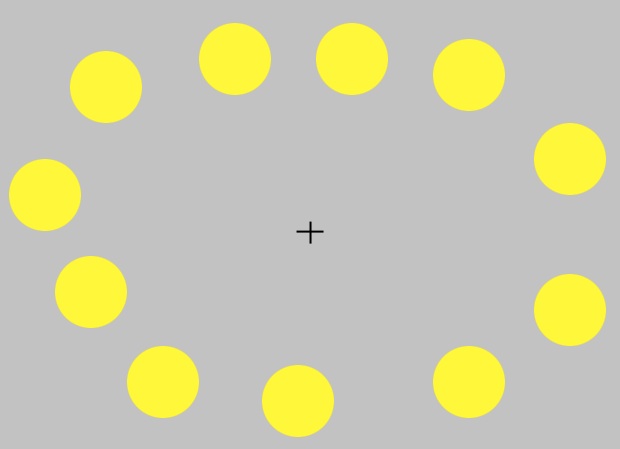Solved: How Optical Illusion Turns Circles Into Hexagons

When you stare at a colorful image and then turn to look at a neutral background, a "ghost image" appears in contrasting colors. Now, new research finds that a similar illusion occurs with shapes, turning circles into hexagons and vice versa.
Though similar, the two visual phenomena have different causes. While the color optical illusion, occurs because of tired-out light-sensing cells in the eye, the shape afterimage illusion arises from the visual parts of the brain, said study researcher Hiroyuki Ito, of Kyushu University in Japan.
"Afterimages are generally unnoticed or blurred," Ito wrote in an email to LiveScience. But for scientists, the images can offer tantalizing clues as to what's going on in the brain.
Circle or hexagon?
The visual effect in which one color becomes another in afterimages is well-known and well-understood. It occurs when light-sensing cells in the eye adapt and lose sensitivity, sending signals to the brain that are identical to the signals that would be sent if you were looking at the opposite color.
Few people, however, notice that the shape they see in an afterimage may not be the one they've been staring at in real life.
Ito found that when study participants stared at circles or hexagons for 10 seconds and then looked at a gray background, those who looked at circles almost always saw an afterimage of hexagons. Likewise, participants who looked at hexagons very often saw circular afterimages. (You can try it here.)
Sign up for the Live Science daily newsletter now
Get the world’s most fascinating discoveries delivered straight to your inbox.
Ito tried a series of experiments with outlined and filled hexagons and circles that were both stationary and rotating. In each case, volunteers were asked to focus on a black cross that was surrounded by a hexagons or circles on a computer screen. After 10 seconds, a gray background appeared, upon which their brain would impose an afterimage. The observers were asked to report which of seven shapes — including triangles, squares, hexagons and dodecagons — the afterimages most resembled.
The illusion was consistent, Ito found, with some people even starting to observe the transition happening as they stared at the shapes, seeing circles degrade into hexagons and vice-versa.
But those findings didn't explain why the illusion exists. Color afterimages arise in the eye after retinal cells adapt and become desensitized to the color at which you've been gazing. If you stare at a red dot with your right eye only, the afterimage will appear only in that eye, and not your left eye.
If shape afterimages arise in the eye, the same right-eye, left-eye phenomenon should be true of seeing hexagons and circles. So Ito arranged experiments with computer monitors and mirrors so that participants saw different images in their right and left eyes. In all cases, the image beamed to the right eye was that of six stationary circles. The image to the left eye changed, with some people seeing stationary circles, others rotating circles, rotating stars or rotating hexagons. After fixating on the images, the volunteers reported what shape afterimage they saw in their right eye. [Amazing Optical Illusions]
All in the mind
The results showed that participants' right-eye afterimages changed along with what the left eye saw. For example, when the left eye focused on rotating circles, the right eye, respondents reported, saw angular hexagon afterimages. But when the left eye saw rotating hexagons, the right eye saw circular afterimages.
If shape afterimages were caused by the retina, the right-eye view wouldn't change along with the left. That, Ito said, suggests that the illusion arises in the brain's visual processing area. The results will appear in January in the Association for Psychological Science (APS) journal Psychological Science.
The exact culprits aren't nailed down, Ito said, but it likely works like this: Certain brain cells respond to curves, corners or both. To prevent double vision, curve and corner cells likely suppress one another so that a strong "corner" signal will wipe out weaker "curve" signals. Thus, even though an image of a stop sign might trigger a small "curve" response in some brain cells, the "corner" signal shuts it down, and you see an angular shape.
But when you stare hard at a shape, those cells get exhausted, just as retinal cells get adapted to one color. That's where the illusion kicks in.
"When one detector gets fatigued through prolonged observation, the other detector dominates," Ito said. "Thus, a circle and a hexagon exchange their shapes in afterimages."
Ito plans to work with neuroscientists to measure brain activity and pinpoint these curve- and corner-detecting cells. He's also keeping an eye out for other examples of strange visual illusions, he said.
"People tend to think that afterimages are meaningless byproducts arising from the physiological characteristics of the eye,"Ito wrote in an email to APS. "But I think that the afterimages reflect brain activities and provide us the means to know those activities in a directly visible form."
You can follow LiveScience senior writer Stephanie Pappas on Twitter @sipappas. Follow LiveScience for the latest in science news and discoveries on Twitter @livescience and on Facebook.

Stephanie Pappas is a contributing writer for Live Science, covering topics ranging from geoscience to archaeology to the human brain and behavior. She was previously a senior writer for Live Science but is now a freelancer based in Denver, Colorado, and regularly contributes to Scientific American and The Monitor, the monthly magazine of the American Psychological Association. Stephanie received a bachelor's degree in psychology from the University of South Carolina and a graduate certificate in science communication from the University of California, Santa Cruz.










